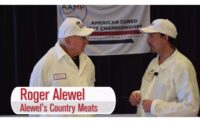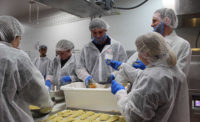DINNER SAUSAGE
Edging Out the Competition
By Megan Pellegrini, contributing writer
Dinner sausages continue to gain steam, and offer more creative flavors and packaging.
In the past three years, branded and private-label sausage producer J Bar B has made more than 35 types of flavored sausages for customers.
“We call them the Gucci sausages,” says Shawn Brammall, director of technical services for J Bar B Foods, based in Waelder, Texas. “A lot of them are ‘in and out’ — they are a hit for a short time and then people go onto something else — but flavored sausages are still a growing area.”
Dinner sausages today can’t play it safe anymore. The grocery case carries apple Gouda, chipotle cheddar or Thai spice flavored sausages, alongside the traditional bratwursts, Italian and Polish sausages and hot dogs. This isn’t a new trend — flavored sausage has been gaining steam for about seven years — but look for new entries to offer even more creative flavors and packaging to keep consumers happy.
According to the Washington, D.C.-based National Hot Dog and Sausage Council (NHDSC), more than 485 million packages of dinner sausages were sold last year, which equals more than $1.5 billion in total sales. The category has shown impressive growth since 2000, with a slight decline in the past two years, says Tonya Allen, spokesman for NHDSC.
| Top 10 Refrigerated Dinner Sausage Brands* | |||||
| Top Brands | Dollar Sales | Dollar Sales % Chg YAgo | Dollar Share | Unit Sales | Unit Sales % Chg YAgo |
| 1. Hillshire Farm | $284,319,900 | 1.83 | 17.10 | 97,142,130 | 3.74 |
| 2. Johnsonville | $278,264,000 | 7.58 | 16.74 | 67,311,010 | 7.33 |
| 3. Private Label | $132,316,900 | 2.29 | 7.96 | 44,053,980 | 0.70 |
| 4. Eckrich | $77,634,910 | (5.54) | 4.67 | 27,192,950 | (4.17) |
| 5. Aidell’s | $31,000,250 | 13.10 | 1.86 | 5,214,823 | 12.44 |
| 6. Bar-S | $28,334,830 | 6.24 | 1.70 | 9,043,168 | 24.18 |
| 7. Premio | $28,066,150 | (1.52) | 1.69 | 8,307,109 | 0.61 |
| 8. Johnsonville Beddar With Cheddar | $27,712,640 | 13.22 | 1.67 | 8,314,258 | 12.28 |
| 9. John Morrell | $25,690,180 | (9.09) | 1.55 | 13,692,680 | (11.82) |
| 10. Hillshire Farm Cheddarwurst | $23,992,080 | 11.62 | 1.44 | 8,361,617 | 17.71 |
| Total Category | $1,662,724,000 | 2.48 | 100.00 | 519,829,900 | 2.13 |
| *TOTAL U.S. - F/D/MX (supermarkets, drugstores, and mass merchandisers (excluding Wal-Mart)), for the 52 weeks ending July 15, 2007. Source: Information Resources Inc. | |||||
| Top 10 Refrigerated Frank Brands* | |||||
| Top Brands | Dollar Sales | Dollar Sales % Chg YAgo | Dollar Share | Unit Sales | Unit Sales % Chg YAgo |
| 1. Oscar Mayer | $304,128,500 | (0.66) | 18.84 | 115,508,600 | (1.55) |
| 2. Ball Park | $268,974,200 | 0.62 | 16.66 | 97,194,890 | (0.01) |
| 3. Bar-S | $136,339,100 | 0.95 | 8.44 | 125,052,400 | 2.39 |
| 4. Hebrew National | $103,936,100 | 19.69 | 6.44 | 28,092,700 | 20.64 |
| 5. Private Label | $89,826,580 | (9.21) | 5.56 | 57,073,020 | (10.70) |
| 6. Nathan | $88,758,980 | 12.14 | 5.50 | 22,922,430 | 11.59 |
| 7. Gwaltney | $42,879,050 | 4.74 | 2.66 | 32,210,630 | 3.62 |
| 8. Bryan | $27,273,050 | (9.95) | 1.69 | 14,479,820 | (8.20) |
| 9. John Morrell | $25,561,090 | (3.86) | 1.58 | 23,509,130 | (7.30) |
| 10. Eckrich | $22,361,010 | (6.81) | 1.38 | 14,588,310 | 1.27 |
| Total Category | $1,614,558,000 | (1.11) | 100.00 | 757,940,700 | (3.08) |
| *TOTAL U.S. - F/D/MX (supermarkets, drugstores, and mass merchandisers (excluding Wal-Mart)), for the 52 weeks ending July 15, 2007. Source: Information Resources Inc. | |||||
“It’s still a huge market,” she says. “Sausages of all varieties have enjoyed unprecedented success due to new flavors, products and tasting standards.”
Indeed, sausage links continue to gain in popularity over their larger counterparts, rope or ring sausage. Consumers currently prefer all-pork (53 percent) to link sausage (42 percent).
Once thought of as the hot dog’s lesser-known cousin, sausages are now outselling hot dogs at retail. Although the sausage category decreased in sales by 1 percent, frankfurters posted a
4 percent drop in sales, which knocked them behind sausages for the first time.
Sausages are also competing with or outselling hot dogs at many Major League Baseball ballparks today, says Allen. Understandably, that’s been the case at the Milwaukee Brewers’ Miller Park, located in the land of beer and brats, where one can even choose specialty-flavored sausages.
According to NHDSC’s consumer research, sausage products’ convenient packaging, detailed preparation and usage information, and consumers’ interest in low-carb diets all contributed to driving sales at retail. The upscale, gourmet flavors are an added bonus. Indeed, Johnsonville Sausage Inc., based in Sheboygan, Wis., carries at least 33 flavors, and recently added Smoked Turkey Sausage and Turkey with Cheddar Sausage to its lineup.
New products are featuring increased protein content, less fat and even more distinctive flavors such as teriyaki and brown sugar. These sweeter flavors are well-received by customers. Half of all consumers, points out Allen, prefer mild or regular sausage to hot or spicy varieties.
“Retailers are asking for something different, and we’re spending lots of research and development on it,” says Brammall.
Last fall, J Bar B introduced the spicy Texas Smokehouse Sausage, which requires no refrigeration due to the company’s processing system. This advanced packaging system cooks and cools the product in the bag, extending its shelf life from the standard 80 days to 120 days and preventing microbiological contamination and cross-contamination.
Private-label sausages continue to show strength as they posted a 2.3 percent gain in dollar sales this year.
Natural and organic sausages are also showing tremendous growth. Niman Ranch and Coleman Natural Foods are among the natural and organic meat processors offering dinner sausages. According to Robyn Nick, director of communications and cause marketing, Coleman Natural Foods, based in Golden, Colo., “natural” and “sausage” are a better fit than one might presume.
“Research tells us that that nearly three out of four women feel their conventional grocery stores should offer meats free of hormones and antibiotics,” she says, “and 31 percent of current non-buyers would buy all-natural meats if given the option at their local grocery store.”
Coleman offers five natural flavors and five organic flavors. “Each sausage is trans fat-free and naturally flavored with no artificial ingredients,” she says. “The result is a full-bodied, flavorful, juicy tasting sausage every time.”
The dinner sausages carry the “never, ever” promise of no antibiotics, growth hormones or artificial ingredients.
Studies and surveys still indicate consumer confusion over the definition of natural, and generally have higher expectations for the “natural” label regardless of gender, age, income or region. Nick points out that more than eight in 10 said the “natural” label on meat should mean: It came from an animal whose diet was natural and free of chemicals, drugs and other artificial ingredients (89%); no artificial colorings or other ingredients were used in the cut of the meat or meat product (84%); and it came from an animal that was raised in a natural environment (83%), according to Consumer Reports National Research Center’s Food-Labeling Poll in June.
As companies review whether to add natural and organic varieties to their product lines, they can rest assured that they are doing a good job staying on top of trends and setting trends.
“Their success shows they are able to adapt,” notes Allen. Industry experts, she continues, say the entire refrigerated processed meat category should be able to reach approximately $22.49 billion in sales by 2009, with sausage as a key component of success.


